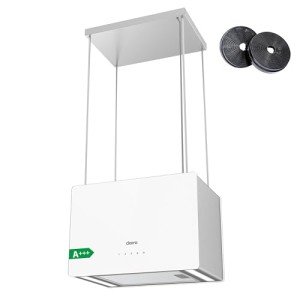You'll Never Guess This Cooker Island Hood's Tricks
페이지 정보
작성자 Tamara 날짜25-02-25 02:57 조회0회 댓글0건본문
How to Choose a Cooker Island Hood
A cooker island hood gets rid of cooking fumes, smoke, and odours to keep your kitchen air fresh. Before buying, it is necessary to measure your hob and kitchen ceiling to ensure that the hood will be a good fit.
Kitchen hoods can be wall-mounted, incorporated into cabinets, or made part of a canopy in your ceiling. They can be expanded when in use or retracted and hidden away.
Size
When purchasing a cooker hood, size is an essential element to consider. The very best size of a kitchen cooker island hood depends upon your cooking practices and the layout of your area. The ideal hood must be at least as broad as your cooktop to ensure that it covers all of the area when it remains in use, so it can successfully catch smoke and odors while in operation.
Choosing the best kitchen hood size also depends upon how much ventilation you need in your space. The CFM ranking of a hood is an indicator of how many cubic feet per minute it can move. As a general rule, you need to get a hood with a CFM score that matches the square video footage of your kitchen to guarantee reliable ventilation.
For smaller kitchen areas, slimline cooker hoods are a great option as they are designed to fit underneath and above overhead cabinets. However, they typically have less suction power and may not be suitable for families that do a great deal of heavy cooking. For bigger cooking areas, island and chimney hoods supply more efficient extraction and ventilation.
Island range hoods are suspended from the ceiling above your kitchen island and use more efficient ventilation for your cooking area. They are available in a variety of styles and sizes to match various kitchen designs. They can also be ducted or ductless. Ducted hoods will vent outside of your home while re-circulating hoods will filter and vent back into your kitchen.
The installation procedure of a kitchen hood is intricate and needs expert aid. It is also a good idea to follow the producer's instructions carefully to avoid unexpected problems. When installing your hood, it is also essential to install it at the appropriate height above the cooktop. The hood needs to not hang expensive as it can lower its effectiveness and interfere with your presence while cooking. The optimal height is between 24 and 30 inches above the cooktop.
Design
Island cooker hoods hang from your ceiling, developing a sleek and modern addition to your kitchen. They're a godsend for avid home cooks or anybody who spends a lot of time in their kitchen, structured air flow and assisting keep smoke, odors, and grease under control. They likewise come in a range of designs to match any style, from smooth and almost a decoration piece to sturdy workhorses that go undetected below your cabinet.
They are usually set up above the center of your island or gas range, depending on the maker's advised ceiling height. Nevertheless, if you have a high ceiling, it's best to set up an extension package that can be purchased from the same brand name or online to ensure your hood is at the best height for optimum efficiency.
These are normally simple to install, but it's a good idea to work with an expert to do the task to avoid any mechanical issues in the future. It's also important to consult the hood maker's guidelines to make sure the installation procedure is done correctly, especially for high ceilings.
This beautiful designer Italian-style hood from Cosmo features a sleek stainless steel body and curved tempered glass visor to blend in with your décor. Its 380 CFM of suction effectively rids your kitchen island extractor of contaminants, smoke and cooking smells while the stainless steel ARC-FLOW irreversible filters are dishwasher safe for simple upkeep. Quickly control power, lighting and 3 fan speeds with the push of a button on the soft touch controls.
If you desire a downplayed and elegant alternative, consider a wall install vent hood that hides ductwork in your cabinets. These are smaller sized than canopy hoods, and they're more discrete so you can concentrate on your kitchen's design. However, they have lower suction than bigger hoods and may not be as efficient for heavy cooking.
You can pick a model with LED lighting choices to light up the cooking area below, and lots of designs likewise have push-button control abilities so you can change the fan speed and lights from throughout your space. Some even include a night light setting that can subtly accent the space while providing a soft radiance.
Extraction
A cooker hood in your island kitchen assists to clarify, eliminating undesirable steam, grease and cooking odours that can cause unattractive sticky residues on surface areas, making them more difficult to clean. This can also encourage mould growth and cause damage to cabinet paintwork in time.
A trendy and reliable extractor hood will help to keep your cooking location tidy and fresh, especially in big open strategy areas where smells can take a trip further into other locations of your home. Our range of high-performance island hoods offer effective extraction, a sleek design and advanced functions like automatic controls and LED job lighting.
There are four main kinds of extractor hoods that can be installed over an island; chimney extractor, ceiling installed, downdraft and wall-mounted. Picking the right type depends on your design preferences and extraction requirements.
Chimney extractors sit above the hob and, when triggered, a downdraft increases from the worktop to record smoke, fumes and odours. They are the most reliable choice for island ventilation hoods extraction and can be vented out through ducting (with proper ducted extractor fan ducting kit).
Ceiling installed hoods are a discreet alternative to chimney and downdraft models, sat flush with your ceiling to develop a seamless finish. Activated by pushing a button, they draw in the air through a concealed vent and can be set to recirculate or vent outside, depending on your requirements.
Downdraft extractors are hidden from view under your counter top and, when triggered, increase vertically to the preferred height. They can be set to recirculate or to vent externally, and are ideal for cooking areas with an incorporated oven.
For a more decorative alternative to traditional hoods, our variety of stainless steel island extractor fans use an unique look that will become the centerpiece of your kitchen. With a minimalist, circular design and effective extraction rates, they will fit any style of kitchen while offering exceptional efficiency. Select from a variety of finishes consisting of silver and black island extractor fan, to match your existing kitchen décor while adding a strong design declaration. Our stainless-steel island extractor fans included a dishwasher-safe aluminium grease filter, automated controls and LED downlights.
Noise
If your cooker hood isn't as peaceful as it used to be, the extractor fan motor might be damaged. It can be triggered by rust, wetness, or grease accumulation, which prevents it from operating appropriately. This results in sounds, such as a loud whirring noise. If this occurs, you will have to change the motor.
A loud hood can be very frustrating, cooker island hood particularly in open-plan cooking areas and living spaces. This is why it's essential to select one that provides excellent extraction capabilities without causing extreme noise. Numerous brands offer silent cooker hood designs that can attain this objective.
Duct System Issues
If there's an imbalance in air pressure in the ducting system of your cooker hood, it can cause turbulence. This can produce acoustic vibrations that manifest as sound, even when the hood is switched off. To examine if this is the case, locate where the ducting meets the wall and inspect it for signs of damage. If the ducting is venting out the front or back of the hood, eliminate the chimney cover and utilize a torch to see if there are any obstructions in the ducting.
Other problems that can trigger your hood to make odd sounds are loose parts or a faulty switch. If the hood is hardwired, it's necessary to make sure that the circuit breaker that supplies power to the hood is switched off. If the hood isn't hardwired, you can check the wiring and the electrical switches for any damage or wear-and-tear.
The nozzle of your cooker hood's exhaust fan can likewise cause issues if it is filthy or obstructed by grease. If the nozzle is dirty, it can create a clapping noise. If it's obstructed by grease, you can apply a piece of blu tack to reduce the clapping.
Cooker hood noise levels are usually suggested in decibels (dB) on the product label or in its specifications. The number depends upon the distance and fan speed measurements that the hood is checked at. The producer will follow standardised screening treatments to ensure that the information is precise.
A cooker island hood gets rid of cooking fumes, smoke, and odours to keep your kitchen air fresh. Before buying, it is necessary to measure your hob and kitchen ceiling to ensure that the hood will be a good fit.
Kitchen hoods can be wall-mounted, incorporated into cabinets, or made part of a canopy in your ceiling. They can be expanded when in use or retracted and hidden away.
Size
When purchasing a cooker hood, size is an essential element to consider. The very best size of a kitchen cooker island hood depends upon your cooking practices and the layout of your area. The ideal hood must be at least as broad as your cooktop to ensure that it covers all of the area when it remains in use, so it can successfully catch smoke and odors while in operation.
Choosing the best kitchen hood size also depends upon how much ventilation you need in your space. The CFM ranking of a hood is an indicator of how many cubic feet per minute it can move. As a general rule, you need to get a hood with a CFM score that matches the square video footage of your kitchen to guarantee reliable ventilation.
For smaller kitchen areas, slimline cooker hoods are a great option as they are designed to fit underneath and above overhead cabinets. However, they typically have less suction power and may not be suitable for families that do a great deal of heavy cooking. For bigger cooking areas, island and chimney hoods supply more efficient extraction and ventilation.
Island range hoods are suspended from the ceiling above your kitchen island and use more efficient ventilation for your cooking area. They are available in a variety of styles and sizes to match various kitchen designs. They can also be ducted or ductless. Ducted hoods will vent outside of your home while re-circulating hoods will filter and vent back into your kitchen.
The installation procedure of a kitchen hood is intricate and needs expert aid. It is also a good idea to follow the producer's instructions carefully to avoid unexpected problems. When installing your hood, it is also essential to install it at the appropriate height above the cooktop. The hood needs to not hang expensive as it can lower its effectiveness and interfere with your presence while cooking. The optimal height is between 24 and 30 inches above the cooktop.
Design
Island cooker hoods hang from your ceiling, developing a sleek and modern addition to your kitchen. They're a godsend for avid home cooks or anybody who spends a lot of time in their kitchen, structured air flow and assisting keep smoke, odors, and grease under control. They likewise come in a range of designs to match any style, from smooth and almost a decoration piece to sturdy workhorses that go undetected below your cabinet.
They are usually set up above the center of your island or gas range, depending on the maker's advised ceiling height. Nevertheless, if you have a high ceiling, it's best to set up an extension package that can be purchased from the same brand name or online to ensure your hood is at the best height for optimum efficiency.
These are normally simple to install, but it's a good idea to work with an expert to do the task to avoid any mechanical issues in the future. It's also important to consult the hood maker's guidelines to make sure the installation procedure is done correctly, especially for high ceilings.
This beautiful designer Italian-style hood from Cosmo features a sleek stainless steel body and curved tempered glass visor to blend in with your décor. Its 380 CFM of suction effectively rids your kitchen island extractor of contaminants, smoke and cooking smells while the stainless steel ARC-FLOW irreversible filters are dishwasher safe for simple upkeep. Quickly control power, lighting and 3 fan speeds with the push of a button on the soft touch controls.
If you desire a downplayed and elegant alternative, consider a wall install vent hood that hides ductwork in your cabinets. These are smaller sized than canopy hoods, and they're more discrete so you can concentrate on your kitchen's design. However, they have lower suction than bigger hoods and may not be as efficient for heavy cooking.
You can pick a model with LED lighting choices to light up the cooking area below, and lots of designs likewise have push-button control abilities so you can change the fan speed and lights from throughout your space. Some even include a night light setting that can subtly accent the space while providing a soft radiance.
Extraction
A cooker hood in your island kitchen assists to clarify, eliminating undesirable steam, grease and cooking odours that can cause unattractive sticky residues on surface areas, making them more difficult to clean. This can also encourage mould growth and cause damage to cabinet paintwork in time.
A trendy and reliable extractor hood will help to keep your cooking location tidy and fresh, especially in big open strategy areas where smells can take a trip further into other locations of your home. Our range of high-performance island hoods offer effective extraction, a sleek design and advanced functions like automatic controls and LED job lighting.
There are four main kinds of extractor hoods that can be installed over an island; chimney extractor, ceiling installed, downdraft and wall-mounted. Picking the right type depends on your design preferences and extraction requirements.
Chimney extractors sit above the hob and, when triggered, a downdraft increases from the worktop to record smoke, fumes and odours. They are the most reliable choice for island ventilation hoods extraction and can be vented out through ducting (with proper ducted extractor fan ducting kit).
Ceiling installed hoods are a discreet alternative to chimney and downdraft models, sat flush with your ceiling to develop a seamless finish. Activated by pushing a button, they draw in the air through a concealed vent and can be set to recirculate or vent outside, depending on your requirements.
Downdraft extractors are hidden from view under your counter top and, when triggered, increase vertically to the preferred height. They can be set to recirculate or to vent externally, and are ideal for cooking areas with an incorporated oven.
For a more decorative alternative to traditional hoods, our variety of stainless steel island extractor fans use an unique look that will become the centerpiece of your kitchen. With a minimalist, circular design and effective extraction rates, they will fit any style of kitchen while offering exceptional efficiency. Select from a variety of finishes consisting of silver and black island extractor fan, to match your existing kitchen décor while adding a strong design declaration. Our stainless-steel island extractor fans included a dishwasher-safe aluminium grease filter, automated controls and LED downlights.
Noise
If your cooker hood isn't as peaceful as it used to be, the extractor fan motor might be damaged. It can be triggered by rust, wetness, or grease accumulation, which prevents it from operating appropriately. This results in sounds, such as a loud whirring noise. If this occurs, you will have to change the motor.
A loud hood can be very frustrating, cooker island hood particularly in open-plan cooking areas and living spaces. This is why it's essential to select one that provides excellent extraction capabilities without causing extreme noise. Numerous brands offer silent cooker hood designs that can attain this objective.
Duct System Issues
If there's an imbalance in air pressure in the ducting system of your cooker hood, it can cause turbulence. This can produce acoustic vibrations that manifest as sound, even when the hood is switched off. To examine if this is the case, locate where the ducting meets the wall and inspect it for signs of damage. If the ducting is venting out the front or back of the hood, eliminate the chimney cover and utilize a torch to see if there are any obstructions in the ducting.
Other problems that can trigger your hood to make odd sounds are loose parts or a faulty switch. If the hood is hardwired, it's necessary to make sure that the circuit breaker that supplies power to the hood is switched off. If the hood isn't hardwired, you can check the wiring and the electrical switches for any damage or wear-and-tear.
The nozzle of your cooker hood's exhaust fan can likewise cause issues if it is filthy or obstructed by grease. If the nozzle is dirty, it can create a clapping noise. If it's obstructed by grease, you can apply a piece of blu tack to reduce the clapping.
Cooker hood noise levels are usually suggested in decibels (dB) on the product label or in its specifications. The number depends upon the distance and fan speed measurements that the hood is checked at. The producer will follow standardised screening treatments to ensure that the information is precise.

댓글목록
등록된 댓글이 없습니다.


















 광송무역
광송무역
 070-7762-8494
070-7762-8494

